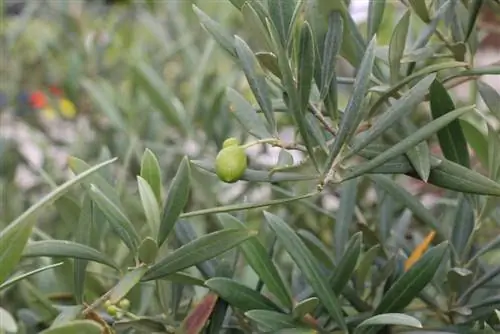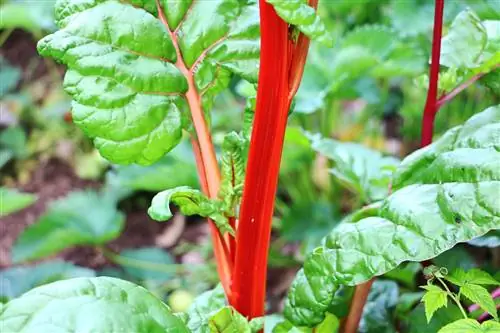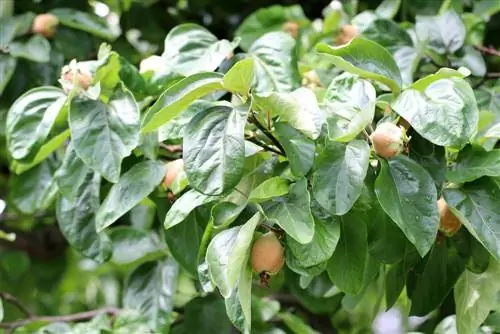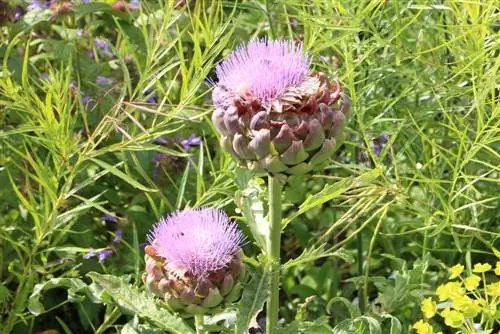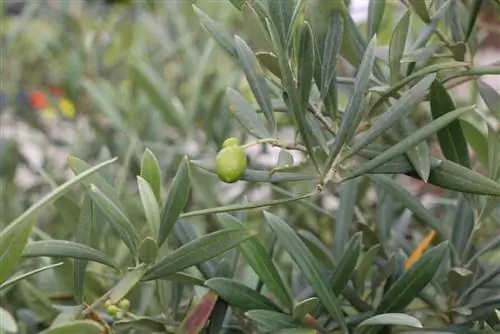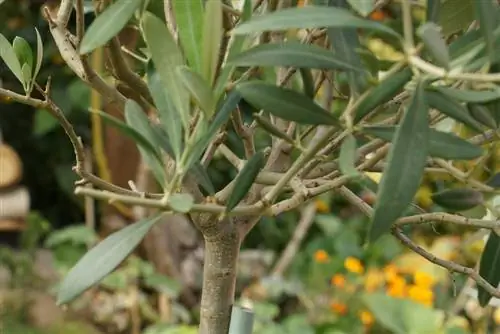- Author admin [email protected].
- Public 2023-12-17 03:39.
- Last modified 2025-01-24 12:45.
Olive trees feel at home wherever there is a Mediterranean climate. It can get cold sometimes. The most important thing is to have lots of hours of sunshine all year round. The more sun, the more flowers, the more abundant the harvest. Another requirement, especially for the German olive harvest, is patience. Maybe you shouldn't approach the matter with too high expectations. It's all the more satisfying to actually be able to harvest some stone fruits from your own olive tree in winter.
Purchasing
If you hope to be able to harvest your own olives one day, you should take this into account when shopping. The best way to do this is to buy the trees from a specialist nursery. Only here can you expect answers about the age, origin and proper care of the olive tree. All of this plays a significant role in the subsequent harvest success. What to look out for when shopping:
Age
Flowering and some fruit can only be expected from the age of at least seven years. You can also say that the older the olive tree, the more fruit it bears. For professional olive harvesting, a tree must be at least twenty years old.
Origin, sensitivity to frost
If the variety comes from the southern Mediterranean areas, it is used to a lot of sun and warm temperatures. The chance that the tree will bloom here is slim. Better they come from the Pyrenees or northern Italy. The further south the region of origin, the more sensitive the olive tree is to frost.
Refining
Olive trees that have been grown through grafting are more likely to bloom than non-grafted varieties. When grafting an olive tree, cultivated olive branches are usually grafted onto a wild olive.
Self-pollination, cross-pollination
Olive trees produce bisexual flowers, so they can basically fertilize themselves. Nevertheless, many varieties are rather unisexual and significant harvest yields can only be achieved in the company of other olive trees. There are some varieties that are sold as designated self-pollinators. However, cross-fertilization is always more promising.
Some varieties of Olea Europaea available here that are considered particularly cold-tolerant:
‘Leccino’
Italian main variety, very frost tolerant
‘Frantoio’
widespread, popular variety from northern Italy; robust and frost-tolerant;
‘Lessini’
from Spain; very frost tolerant and not very susceptible to disease
‘Cailletier’
France; designated as self-pollinating
‘Aglandou’
designated as self-pollinating; well tolerated by cold;
‘Bouteillan’
France Provence; cold-resistant
‘Rougette de l’Ardèche’
particularly cold-tolerant, French variety
‘Cornicabra’ Spain; According to current studies, one of the most winter-hardy olive trees
Bloom
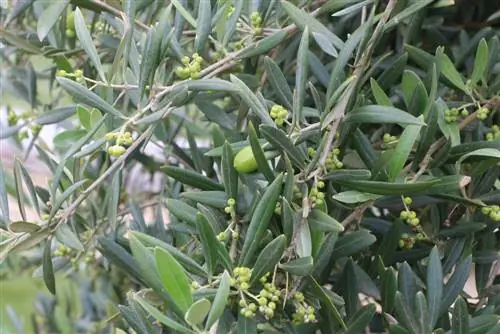
Before the harvest occurs, many small, white flowers must first form in spring, April to May. They sit directly on the branches. Provided the tree is old enough, the hours of sunshine play an important role in the formation of flowers. This means that the tree can bloom in spring if the season starts with a sunny, warm season. If there are no hours of sunshine, you can expect late flowering, in June. If there is any flowering at all. Here in Germany, the overwintering strategy is also an important factor for flowering in spring, depending on the variety, husbandry and region.
Pollination
Usually the main work in pollinating the countless delicate flowers is done by the wind. Of course, insects are also involved. But anyone who has made their olive trees bloom here in Germany should no longer leave anything to chance. So get to the pollen, now manual work is required. With a soft brush you transfer the pollen from the flowers of one tree to the flowers of the other tree. Even if you have a tree that is designated as self-pollinating, it is definitely safer for successful fertilization if pollination takes place from tree to tree.
No flowering, possible causes
- the olive tree is too young
- Wintering too warm (optimal 0 to 5°C)
- Wintering too dark (always hibernate light)
- too few hours of sunshine, warmth (in spring, summer)
- too little/too much water
Tip:
Even though olive trees originally come from dry Mediterranean areas, they should not dry out completely, especially in the pot. In the open field, in their homeland, olive trees develop a deep, large root system and can easily supply themselves with groundwater.
Harvest time
The olives can be harvested from October until February. Olives ripen very slowly. Added to this is personal preference. They can be harvested early and while still green. Then they still have a lot of bitter substances. The longer you wait, the darker (dark purple to black) and fruitier they become. In Germany, however, the harvest will hardly be able to wait until next year. The harvest, if it occurs at all, will depend on the prevailing weather conditions. November, December can be considered a realistic period. A distinction is made between three stages of maturity:
Early ripening stage
The olives are still green. Now their content of polyphenols (secondary plant substances) is at its highest. Professional cultivation is now used to harvest high-quality olive oil. At the same time, green olives contain fewer fatty acids. This explains, among other things, the high price of quality olive oils. To produce a certain amount of oil, three times as many green olives are needed as ripe black olives.
Advanced maturity
Many weeks later, the olives slowly become lighter, yellowish green. Some are already turning slightly purple. Now they are no longer so bitter, the flesh has become a little softer. They now taste a little milder, slightly spicy, but still bitter.
Final stage
At some point in winter the olives turn deep black. Now they are fully ripe. The content of secondary plant substances has decreased, but they no longer taste bitter, but almost a little sweet. Now the fatty acid content is at its highest and this is also reflected in the calories.
Harvest
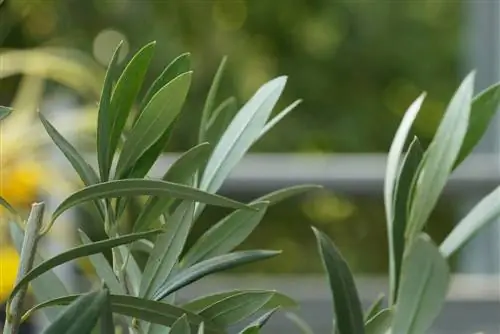
To make a long story short, in Germany people pick and not shake. In our climate zones there will be far too few and too few fully ripe fruits to be able to lay out nets and shake the trees. The olives are picked by hand here, depending on the climate and weather. The main harvest months will be November and December. Even if they are not ripe, the olives should be of a certain size. Unfortunately, in our climate, it also happens that they fall off immature before they reach their final size. This is usually due to the lack of sunshine at the end.
Since the harvest is unlikely to be enough to produce oil, after picking, the aim is to produce the most delicious snack olives possible. Because straight from the tree to the mouth, that doesn't work with olives. A lot of preparation is required for the final olive enjoyment.
Consumption
No matter whether unripe, ripe or half-ripe, after the olives are harvested they need a certain treatment so that they are edible. The bitter substances must be removed:
- Score or squeeze the olives several times with a knife
- place in clear water (olives must remain completely submerged)
- Change the water daily for 4 to 6 weeks
- then make brine (approx. 100 g of s alt for 1 liter of water)
- add half a cup of vinegar or lemon juice
- You can also add herbs and garlic to taste
- The olives can be stored in a sealed container in the refrigerator for up to a year
Conclusion
Just cultivating an olive tree in a container or even outdoors over several years is a proud gardening achievement. Anyone who manages to get their Olea europaea to bloom and pollinate it successfully deserves the highest praise. Although the olives cannot be enjoyed immediately after picking, with the right follow-up treatment you can still score points at the table with your own olives.

